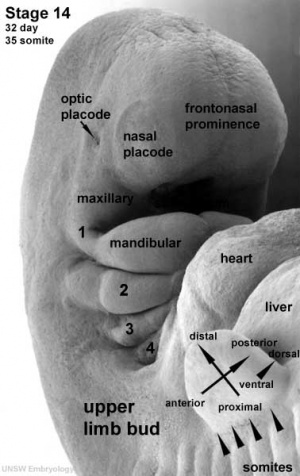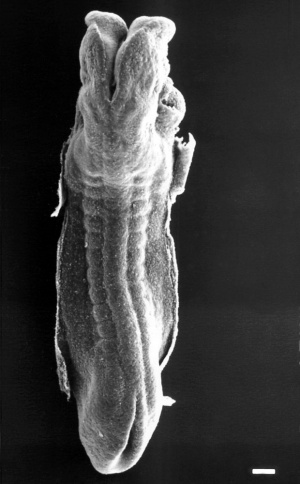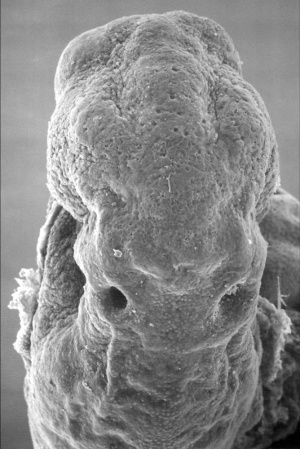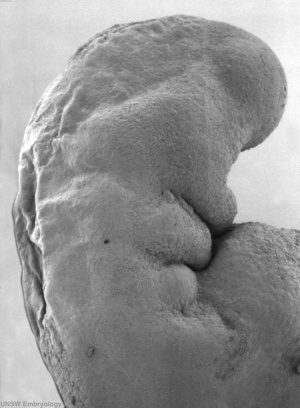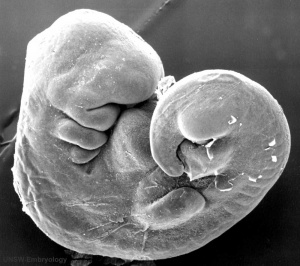Placodes: Difference between revisions
No edit summary |
|||
| Line 60: | Line 60: | ||
:'''Links:''' [[Hearing_-_Inner_Ear_Development|Inner Ear]] | [[Sensory_-_Hearing_and_Balance_Development|Hearing and Balance Development]] | :'''Links:''' [[Hearing_-_Inner_Ear_Development|Inner Ear]] | [[Sensory_-_Hearing_and_Balance_Development|Hearing and Balance Development]] | ||
==Adenohypophyseal Placode== | |||
==Olfactory Placodes== | |||
(Nasal) | |||
==Optic Placodes== | |||
(Lens) | |||
Lies on the surface, adjacent to the outpocketing of the nervous system (which will for the retina) and will form the lens. | |||
==Trigeminal Placodes== | |||
(Profundal) | |||
==Sensory System== | ==Sensory System== | ||
Revision as of 10:44, 7 September 2011
Introduction
Placodes are ectodermal thickenings which have important roles in development of special sensory systems.
In human development, during week 4 a series of thickened surface ectodermal patches form in pairs rostro-caudally in the head region.
Recent research suggests that all sensory placodes may arise from common panplacodal primordium origin around the neural plate, and then differentiate to eventually have different developmental fates. These sensory placodes will later contribute key components of each of our special senses (vision, hearing and smell). Note that their initial postion on the developing head is significantly different to their final position in the future sensory system.
- Adenohypophyseal placode
- Olfactory (Nasal) placodes
- Optic (Lens) placodes - lies on the surface, adjacent to the outpocketing of the nervous system (which will for the retina) and will form the lens.
- Profundal/trigeminal placodes
- Otic placodes - has 2 components (medial and lateral) and will form the nose olfactory epithelium.
Other species have a number of other placodes which form additional sensory structures (fish, lateral line receptor).
- Epibranchial placodes
- Lateral line placodes
- Hypobranchial placodes
Some Recent Findings
|
Otic Placode
The otic placode is the first of the sensory placodes visible on the surface of the developing human embryo. This placode will differentiate to contribute almost entirely the components of the inner ear. The images below show the first appearance on the embryo surface during week 4 and the eventual disappearance from the surface by week 5. This is only the beginning of the complex development of this structure, influenced by the surrounding epidermis, neural tube and neural crest.
The scanning EM of the week 4 human embryo Carnegie stage 11 shown below is a superior dorsal view of the paired otic placodes sinking into the surface at the level of the hindbrain between day 24 and day 25.
By Carnegie stage 12 26 days, only a small opening of the developing otic vesicle (otocyst) remains visible on the embryo surface located behind the second pharyngeal arch.
By week 5 Carnegie stage 13 the otic vesicle (otocyst) is completely formed and is no longer visible on the embryo surface.
Cross-sections of the embryo head at this stage show the otocyst now lies within the embryo as a hollow fluid-filled epithelial "ball", located between the epidermis and the neural tube (hindbrain).

|

|

|

|
| A2L | A3L | A4L | A5L |
- Links: Inner Ear | Hearing and Balance Development
Adenohypophyseal Placode
Olfactory Placodes
(Nasal)
Optic Placodes
(Lens) Lies on the surface, adjacent to the outpocketing of the nervous system (which will for the retina) and will form the lens.
Trigeminal Placodes
(Profundal)
Sensory System
Embryo Week: Week 1 | Week 2 | Week 3 | Week 4 | Week 5 | Week 6 | Week 7 | Week 8 | Week 9
- Carnegie Stages: 1 | 2 | 3 | 4 | 5 | 6 | 7 | 8 | 9 | 10 | 11 | 12 | 13 | 14 | 15 | 16 | 17 | 18 | 19 | 20 | 21 | 22 | 23 | About Stages | Timeline
References
Online Textbooks
- Colloquium Series on Developmental Biology Induction and Segregation of the Vertebrate Cranial Placodes Park BY, Saint-Jeannet JP. San Rafael (CA): Morgan & Claypool Life Sciences; 2010.
- Developmental Biology (6th ed.) Gilbert, Scott F. Sunderland (MA): Sinauer Associates, Inc.; c2000. Chick embryo rhombomere neural crest cells | Some derivatives of the pharyngeal arches | Tissue Architecture of the Central Nervous System | Neuronal Types | Snapshot Summary: Central Nervous System and Epidermis
- Neuroscience Purves, Dale; Augustine, George J.; Fitzpatrick, David; Katz, Lawrence C.; LaMantia, Anthony-Samuel; McNamara, James O.; Williams, S. Mark. Sunderland (MA): Sinauer Associates, Inc. ; c2001 The Auditory System | The Inner Ear | Early Brain Development
- Clinical Methods 63. Cranial Nerves IX and X: The Glossopharyngeal and Vagus Nerves | The Tongue | 126. The Ear and Auditory System | An Overview of the Head and Neck - Ears and Hearing | Audiometry
- Eurekah Bioscience Collection Cranial Neural Crest and Development of the Head Skeleton
Search Bookshelf placode development
Reviews
<pubmed>20460364</pubmed> <pubmed>9927591</pubmed>
Articles
Search Pubmed
June 2010 "placode development" All (852) Review (90) Free Full Text (285)
Search Pubmed placode development | otic placode development | optic placode development | nasal placode development
Glossary Links
- Glossary: A | B | C | D | E | F | G | H | I | J | K | L | M | N | O | P | Q | R | S | T | U | V | W | X | Y | Z | Numbers | Symbols | Term Link
Cite this page: Hill, M.A. (2024, May 1) Embryology Placodes. Retrieved from https://embryology.med.unsw.edu.au/embryology/index.php/Placodes
- © Dr Mark Hill 2024, UNSW Embryology ISBN: 978 0 7334 2609 4 - UNSW CRICOS Provider Code No. 00098G
